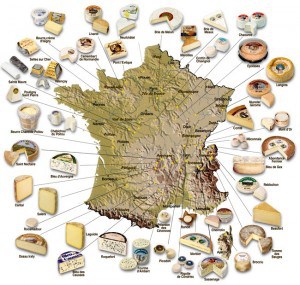
In this blog series, Molly will be (virtually) traveling around the globe to explore the way cheeses are enjoyed and incorporated into different cuisines. Some of these cheeses and methods might seem familiar, while others might be completely new to you. Last week, we talked about where this journey will be taking us, and some of you shared your interests in the comments below. Noel B. was the winner of a free issue of culture – read on to find out how you can win a copy, too! Get more stamps on your cheese passport and join us for a historical and cultural adventure!
Our travels begin in France, a country that has a cheese tradition that is so rich, Charles DeGaulle said of it: “How can anyone govern a nation that has two hundred and forty-six different kinds of cheese?” A French proverb claims, “un fromage par jour de l’année” – there is a different cheese for every day of the year. It depends on who you ask, but that number is probably low, with some people claiming there are 350 to 400 distinct types of French cheeses, while others say that figure is closer to 1,000. The French consume about 53 pounds of cheese per person annually (second only to Greece, at 68 pounds per capita each year.) I know France and cheese are closely connected, if not synonymous, but why?
To find the answer to this question, I needed to examine what makes this country so well-suited for cheese production. We throw around the word terroir a lot when talking about cheese, but the geography, soil, and climate of a region plays an important role in contributing to the flavor of milk from the cows, sheep, and goats that produce these iconic French cheeses. Despite being geographically smaller than the state of Texas, France has a wide variety of climates, ranging from the salty coastline to rolling pastures. A true Roquefort produced from milk from sheep that grazed in the Midi-Pyrenees will taste much different than one made with milk from sheep that enjoyed a different salad bar.
A map showing some popular French cheeses and the regions they hail from | Photo Credit: Image courtesy of Ma Belle France
In addition to the varying climates in the country, influences from neighbors has also affected France’s cheese culture. Spain, Italy, and Belgium are just a few examples of countries that share a border with France, and when these cultures collide, the result is a unique and well-defined cheesemaking tradition, such as the Comté produced in the Alpine region of the country that’s next to Switzerland. Historical conflict also played a role in shaping the traditions of cheese production. The Loire Valley is known for its goat’s milk cheese because warriors from Arabia brought goats with them when they invaded in the 8th century.
The influence of microclimates and history created an array of cheeses so spectacular that they required their own course at dinner: The cheese course, a sacred tradition in French cuisine. The cheese course is usually served directly after the main course, but before dessert, or sometimes instead of dessert. Devoting an entire course to cheese gives it the appreciation it deserves. Choosing which cheeses to serve is an art form, but classically, the French have at least three cheeses, either representing different milks or different families of cheeses, such as a fresh cheese, a natural rind cheese, and a washed rind cheese. See more of our tips for creating a cheese plate here!

A cheese plate showcasing a variety of cheeses and accompaniments | Photo Credit: Image courtesy of Food Network
Obviously, I’ve only scratched the varied surface of the cheese culture in France, but it’s time for us to move onward to Italy. Stay tuned to learn all about Italian cheese culture next week.
What’s your favorite type of French cheese? Have an especially tantalizing cheese plate combo you want to share? Tell us about it in the comments below for a chance to win a copy of our Cheese+ pairings issue! Comments must be posted by 11:59 p.m. EDT on Tuesday, July 8, 2014 to be eligible to win. So comment today and stay tuned for next week’s post!
Photo Credit: French flag made from cheese courtesy of Parist of France





please send me the whole information about cheese
Hi! Could you explain what you mean?
Camembert, definitely!
Epoisses
Brie, although I wish I had access to more varieties to experience